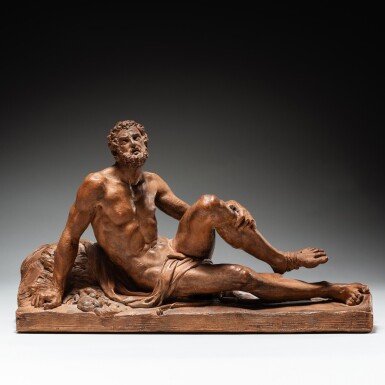
Attributed to Jean Guillaume Boichot (1735 - 1814)
Philoctetes
Estimate
30,000 - 50,000 EUR
Lot Details
Description
French, circa 1788
terracotta
23 by 39 by 14cm.; 9 by 15⅜ by 5½in.
Sotheby's Paris, 14 April 2010, lot 116;
With Daniel Katz, London, 15 March 2012;
Where acquired.
C.-C. Lebas de Courmont, Vie de Guillaume Boichot de l’Académie de sculpture et membre correspondant de l’institut, Paris, 1823;
S. Lami, Dictionnaire des sculpteurs de l’école française au dix-huitième siècle, Paris, 1910, pp. 75-81.
In the last years of the Ancien Régime, French artists produced numerous depictions of Philoctetes, the both heroic and vulnerable companion of Ulysses who would become one of the emblematic figures of revolutionary virtues. In gratitude for his loyalty to Hercules, he was given the latter's bow and arrows poisoned with the venom of the Lernaean Hydra, the only weapons capable of bringing victory to the Greeks over the Trojans. Accidentally wounded in the foot by one of Hercules’ arrows, Philoctetes is subsequently abandoned by Ulysses and the Argonauts on the island of Lemnos. He survived there for ten years, left to his own devices and tortured by the pain radiating from the incurable wound. Finally rescued by those who had abandoned him, and torn between resentment and duty, Philoctetes decided to overcome his bitterness to bring victory to his homeland. A tragic figure par excellence, Philoctetes embodies the classic heroic virtues of courage and self-sacrifice, mirroring revolutionary ideals.
In 1784, Jean-Joseph Taillasson choses to paint the primacy of duty over feelings in Ulysses and Neoptolemus taking Hercules' arrows from Philoctetes (Louvre Museum, inv. 8079); in 1788, Jean-Germain Drouais, then a student at the Académie de France in Rome, focused on the hero's suffering (Musée des Beaux-Arts de Chartres, inv. 5354); in 1798, Guillaume Guillon-Lethière gave an almost pre-Romantic interpretation of the subject, depicting the hero abandoned in the heart of a hostile natural environment (Louvre Museum, inv. 6226). Sculptors were also fascinated by the sacrificed hero. Charles-Louis Corbet exhibited a terracotta sculpture of Philoctetes abandoned on the island of Lemnos at the Salon de l'Académie des Arts de Lille in 1782, and again in 1784. In 1785, and again in 1797, François-Nicolas Delaistre exhibited a plaster of Philoctetes on the island of Lemnos, complaining to the gods about the wound he had inflicted on himself with one of Hercules' arrows. A preparatory terracotta, which remained in the sculptor's family, appeared on the market in 2021 (Beaussant-Lefèvre, Paris, 5 November 2021, lot 104); another very similar version, attributed to Delaistre, was sold two years ago (Sotheby’s New York, 27 January 2023, lot 551).
Of all the sculptors who took an interest in Philoctetes, Guillaume Boichot is the most convincing candidate for the attribution of this terracotta. According to his biographer, Lebas de Courmont, Boichot was admitted to the Académie royale on 26 July 1788, with a Philoctetes on the Island of Lemnos (op. cit., p. 22). Lami suggests that this may be a case of confusion with the figure of Telephus, King of Mysia, pulling an arrow shot by Achilles from his thigh, exhibited by Boichot at the 1789 Salon (no. 284; op. cit., p. 79). As the subjects are sufficiently distinct, it seems more likely to us that these two now lost works are separate. The slender anatomy of the present Philoctetes, probably a preparatory study for the sculptor's morceau d’agrément, is comparable to other male representations by Boichot. A striking comparison is Meleager in the Calydonian Boar Hunt on a pair of terracotta vases currently on loan at the Metropolitan Museum of Art (inv. L.2016.18.1, 2). The facial features of Philoctetes are also comparable to those of the Hercules au resting for the Pantheon, known from two bronze reductions cast by Crozatier (Los Angeles County Museum, inv. 50.33.27, and Windsor Castle, inv. RCIN 31361).
You May Also Like










